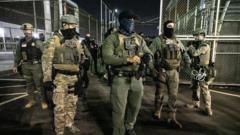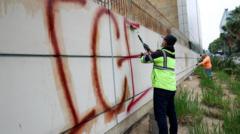The recent civil unrest in Los Angeles, sparked by immigration raids, reflects a broader pattern observed in global protests, according to sociologists.
# Unrest in Los Angeles: Global Patterns Emerge from Protests

# Unrest in Los Angeles: Global Patterns Emerge from Protests
As protests erupt in L.A. over immigration policy, experts draw parallels to international movements and their outcomes.
In Los Angeles, escalating public protests have turned violent after the Trump administration's immigration raids, drawing the National Guard and military into the fray. As societal frustrations mount, images of clashes between demonstrators and law enforcement echo similar incidents seen around the world, where governments have reacted strongly to public dissent.
Expert analyses reveal that initial peaceful protests often devolve into confrontations once state authorities implement a heavy-handed response. Such actions create a feedback loop where governmental crackdowns shape public perceptions, consequently fueling further unrest.
Research on historical protests provides key insights into this dynamic, with three principal lessons highlighted:
1. **The Impact of Media Representation**: Government responses to peaceful demonstrations, often portrayed through stark images of violence, can profoundly influence public sentiment toward both the state and the protesters. The framing of these events in the media plays a crucial role in shaping popular narratives surrounding the conflict.
2. **Historical Context of Protest Movements**: Patterns of protest, from the Arab Spring to various uprisings in Latin America, demonstrate how escalating state violence can often incite larger movements, as populations mobilize against perceived oppression.
3. **Governance and Control**: Historical analysis indicates that leaders may utilize protests as justification for extending their authority or curbing civil liberties. When governments portray dissent as chaotic, citizens may be more inclined to support a crackdown in the name of stability.
As Los Angeles braces for further demonstrations and potential confrontations, these lessons highlight the critical interplay between governmental responses and public perception, revealing timeless truths about the relationship between authority and civil dissent.
Expert analyses reveal that initial peaceful protests often devolve into confrontations once state authorities implement a heavy-handed response. Such actions create a feedback loop where governmental crackdowns shape public perceptions, consequently fueling further unrest.
Research on historical protests provides key insights into this dynamic, with three principal lessons highlighted:
1. **The Impact of Media Representation**: Government responses to peaceful demonstrations, often portrayed through stark images of violence, can profoundly influence public sentiment toward both the state and the protesters. The framing of these events in the media plays a crucial role in shaping popular narratives surrounding the conflict.
2. **Historical Context of Protest Movements**: Patterns of protest, from the Arab Spring to various uprisings in Latin America, demonstrate how escalating state violence can often incite larger movements, as populations mobilize against perceived oppression.
3. **Governance and Control**: Historical analysis indicates that leaders may utilize protests as justification for extending their authority or curbing civil liberties. When governments portray dissent as chaotic, citizens may be more inclined to support a crackdown in the name of stability.
As Los Angeles braces for further demonstrations and potential confrontations, these lessons highlight the critical interplay between governmental responses and public perception, revealing timeless truths about the relationship between authority and civil dissent.



















